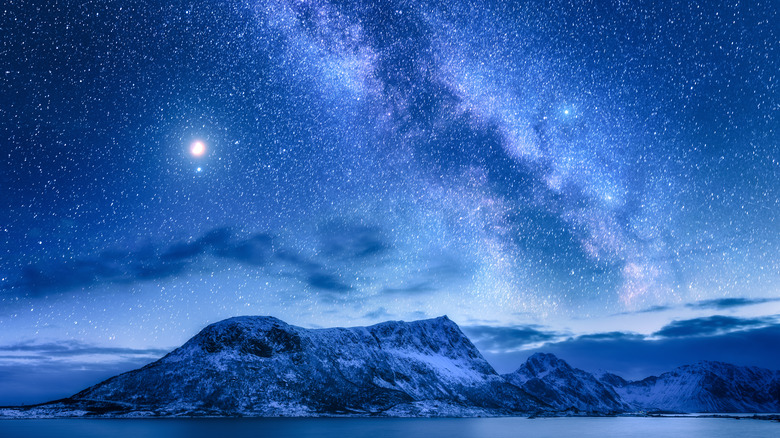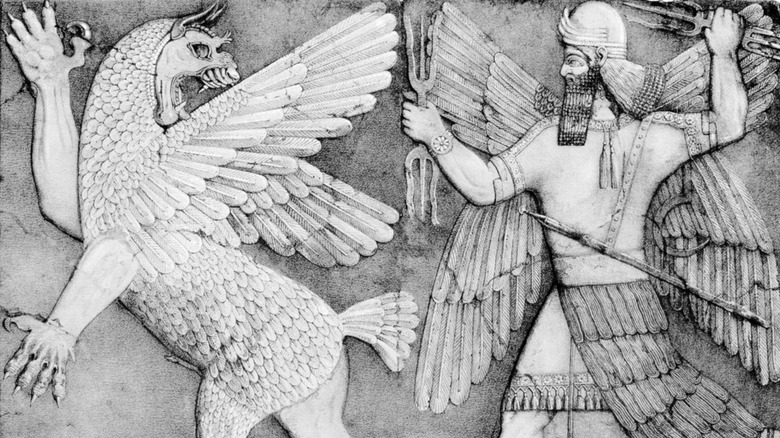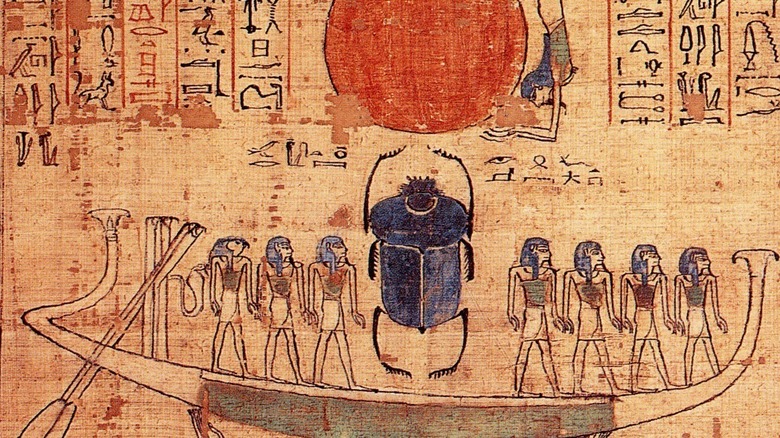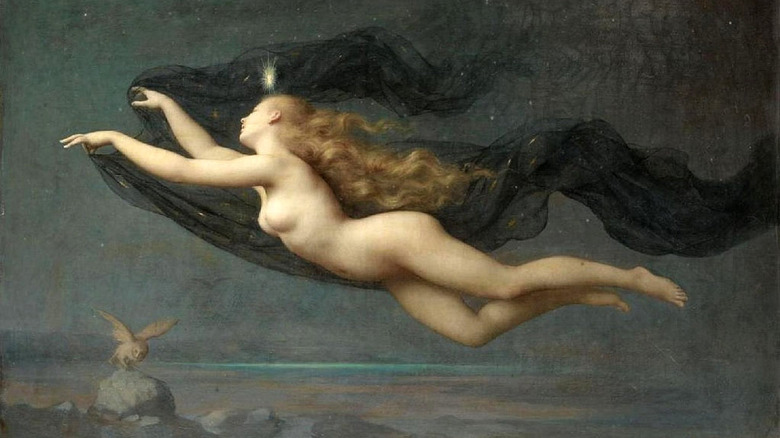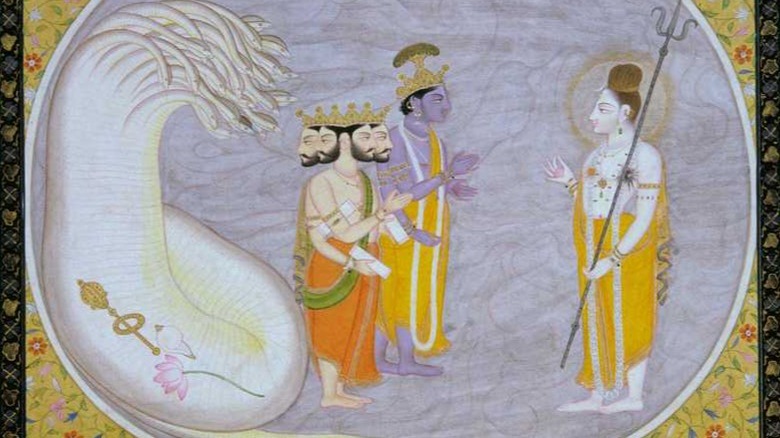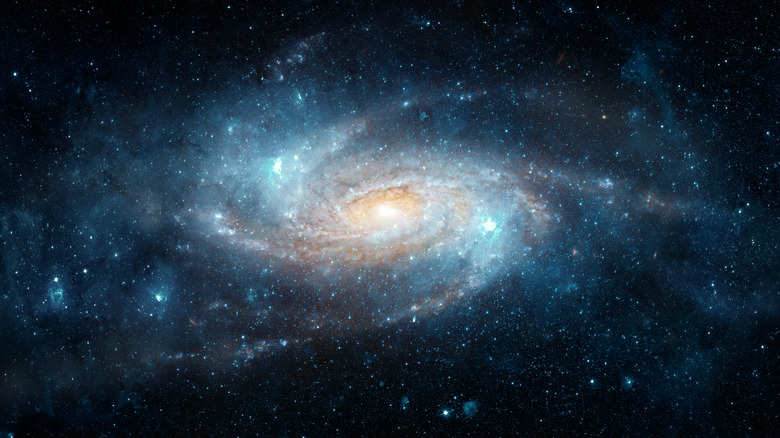The World's Cosmic Ocean Myths Explained
"When in the height heaven was not named / And the earth beneath did not yet bear a name / And the primeval Apsu, who begat them / And chaos, Tiamut, the mother of them both / Their waters were mingled together / And no field was formed, no marsh was to be seen / When of the gods none had been called into being."
Aside from being some lyrically grand, vivid poetry, these lines from the Mesopotamian myth Enuma Elish tell a tale recited by ancient cultures across the world: the story of the primordial, cosmic ocean. Ancient Egyptians talked not about Apsu and Tiamut but Nun and Nunet, god and goddess of the primordial waters, as Wondrium Daily says. In Hindu texts, a single man, Prajapati, formed spontaneously like an egg within the cosmic ocean, per the Rudra Center. In Polynesian myth, it was the creator god Ta'aroa who produced an egg on the cosmic ocean, and in Finnish myth, it was the goddess Ilmatar who got pregnant from the ocean, via the Journal of the Polynesian Society and Kalevalaseura, respectively. On and on the tales go.
If you couldn't tell, many of these stories analogize the primordial waters to the womb and compare the birth of the universe to a human birth. They're also, therefore, full of egg imagery and male/female dichotomies. Even the Hebrew and Christian Bible begins with a similar tale in Genesis of the spirit of God hovering over a cosmic ocean.
Deicide amongst the gods
Because there are so many examples of primordial, cosmic ocean myths from every corner of the globe — Mesoamerican, Mediterranean, North African, Southeast Asian, etc. — we're going to focus on some main ones. Then, we'll tie it all together with some modern astrophysics. After all, the Milky Way kind of looks like an ocean, doesn't it?
The first cosmic ocean story comes from Ancient Mesopotamia, "the land between two rivers," per National Geographic. That area around the Tigris and Euphrates rivers — spreading through modern-day Iraq, Iran, Syria, Turkey, Jordan, and more — gave rise to a whole host of overlapping civilizations. Starting with the Sumerians in about 5,000 B.C.E., and then the Akkadians and Amorites, Mesopotamia reached a cultural peak with the city of Babylon around 1530 B.C.E., as Time Maps shows. Babylon built on an already-ancient, deep foundation of myth when it produced Enuma Elish around 1200 B.C.E. ("The Seven Tablets of Creation"), a creation tale that might have even been copied in its entirety from a 1750 B.C.E. text, as World History Encyclopedia explains.
Enuma Elish contains some of the same elements that show up in other stories. It's got a swirling water of chaos, the division of that water into progenitor gods (freshwater for the male Apsu, saltwater for the female Tiamat), and the birth of subsequent generations of gods. A multi-generational god war ends when the warrior Marduk kills Tiamat and commands the god Ea to create an underclass of lowly laborer-creatures: humans.
A formless, hidden darkness
Another one of our oldest cosmic ocean creation myths comes from Ancient Egypt, which passed through nine distinct eras of history over a stunning 3,100 years, as Discovering Egypt describes. From the Archaic Period to the Ptolemaic Period, around the birth of Jesus, Egyptian civilization underwent tremendous cultural and religious evolution. This is why, unlike the Mesopotamians, the Egyptians didn't bundle their myths into one singular, authoritative tome. As Smarthistory says, the more comprehensive stories of Egyptian myth come from later periods of time.
In general, Egyptian cosmogony — stories about the origins of the universe — centers around the circular nature of time. It begins and ends with a chaotic cosmic ocean. Like Mesopotamia's Enuma Elish, Egyptian chaos spawns a generational tree of gods. The first three generations of gods indwelled within the primordial waters — or defined it — in male and female pairs; Hok and Hoket (formlessness), Kuk and Kuket (darkness), and Nun and Nunet (hiddenness), as Wondrium Daily explains. This last couple presided over the waters directly. The end of the family tree, like Ancient Mesopotamia and Greece, produces the lowliest of creatures: humans.
Before then, the god Atum is the first physical god who rises from an original primordial hill in an act of self-creation (via Wondrium Daily). This is similar to Polynesian, Finnish, or Indian myth. Atum is also sometimes identified with the sun and creates Shu (air) and Tefnut (moisture), who then create Geb (earth) and Nut (sky).
The chaos of the void
The Ancient Greek primordial ocean tale, in many ways, looks like a remixed version of Egyptian and Mesopotamian stories. Folks like the Greek poet Hesiod consolidated various stories into one 700 B.C.E. book describing the origins of the cosmos, "Theogony," as Classical Literature describes. As Theoi explains, Greek myth begins at a similar starting point: a formless, oceanic void. The god Chaos permeated this void, and in some versions, Chaos formed from an egg. In that version, the god Nyx (night) laid the egg in the shape of a giant bird.
Regardless of the version, Chaos and Nyx create the world, starting with the underworld and its ruler Erebus. Then the tale proceeds in a familiar, generational way, starting with Gaia (earth), who gives birth to Uranus (sky) without a mate. They produce a race of progenitor deities (titans) that spawns a subsequent race (gods) that wages war against the former race until a single hero (Zeus) emerges as leader. Zeus, like Marduk, doesn't make humans — he commands an obedient titan, Prometheus, to do so (per Greek Mythology). Prometheus molds clay into the shape of mankind, and the goddess Athena breathes life into it.
In Greek myth, our own terrestrial ocean acted as another secondary, nested cosmic void. As Greek Mythology says, it gave rise to the oldest of the gods, Aphrodite (beauty). And because this is Greek, we've also got some additional familial entanglements and generally petty behavior from the powers that be.
Churning the cosmic ocean
The Ancient Indian cosmic ocean tale retains similarities to other civilizations' stories, but also remains wholly unique in many ways. Remember that "India" didn't exist until 1947. Before that, we've got thousands of years of differing religions, languages, tribal groups, customs, and more with no single, homogenous, agreed-upon canon of cultural identity. And yet, all those Hindu gods that people have come to know — Krishna, Vishnu, Brahma, Shiva, etc. — are present in the Mahabharata, a poetic epic from the 4th-century B.C.E. (per World History Encyclopedia), and the religious Vedas, dating back to 1500 B.C.E. (via World History Encyclopedia). Both derive from much older oral tales.
In India's case, the cosmic ocean is once again the source of creation and reality. As Isrg KB explains, some versions say that a lotus flower sprouted from the bellybutton of the god Vishnu, who was sort of hanging out in the cosmic ocean. Brahma is on the lotus, and he creates Earth, the sky, and the heavens. Earlier versions say that the universe self-created — Big Bang-like — or that the progenitor deity Brahma made it. Yet other versions say that the god Prajapati, eventually identified with Brahma, created the world after emerging from an egg in the cosmic ocean. In any case, like Egypt, Greece, and Mesopotamia, there's an eventual war between Devas (gods) and Asuras (demons) that "churning of the [cosmic] ocean" and spawns poison and treasure, as Sahapedia says. The gods then abandon creation's lowest entities, humans.
Born in the Milky Way
Besides these big, stand-out cosmic ocean stories, lots of other cultures around the world incorporate primordial waters into their myths. We mentioned Polynesia and Finland and also the Bible. The Ancient Aztecs talk about the gods coming from "divine sky water," per Mexico Lore. The Maori don't talk about an ocean, per se, but a kind of primordial nothingness that sounds much like Ancient Egyptian and Greek myth, as The Encyclopedia of New Zealand explains. The Lakota describe people being fished from the waters following a great flood, as First People says.
At this point you might be thinking: What in the world is going on with all these similar "cosmic ocean" stories? Is it a purely unconscious thing, where artifacts in stories reflect recognizable, universal symbols like the womb, eggs, male and female, and so forth? Or do similarities merely come from ancient peoples trying to account for the same Earth and its rain, soil, fire, etc.? In the end, all such myths amazingly echo modern astrophysics, as Big Think outlines. We can tell the same tale in scientific terms, saying, "From the nothingness before the Big Bang came the primordial cosmic ocean of hot, zipping atoms. They fused into the molecules of stars and star clusters called galaxies. Within one galaxy in one solar system cohered the planet Earth, on which land rose from the waters. Earth gave rise to cellular, biological life that fought and competed, and eventually birthed all human life."
